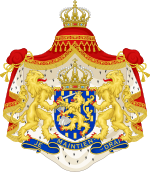- Cals cabinet
-
Netherlands 
This article is part of the series:
Politics and government of
the NetherlandsConstitutionCabinetDecentralized gov'tForeign policyRelated subjects
Cals (14 April 1965 - 22 November 1966) is the name given to a Dutch cabinet, consisting of ministers from KVP, PvdA and ARP.
After the fall of the Marijnen cabinet, the confessional parties did not want snap elections because those could centre around the introduction of commercial television, the issue that led to the fall of the former cabinet. So a new cabinet was formed on the basis of the existing situation. A continuation of the Marijnen cabinet was considered to have too narrow a basis, so PvdA was asked to join in. As a result, DHU stepped out. But previous frictions between PvdA and KVP were overcome because there was a desire to form a cabinet fast, which was indeed done, in just over a month.
After two decades of economic growth, this cabinet experienced a slight recession. Plans to build sports halls, roads and houses had to be tempered. In Limburg the coal mines were closed and plans were drawn to educate and re-employ the former miners.
There was also social unrest ('the sixties'), which became apparent in the Provo movement, construction worker protests, riots over the marriage of princess Beatrix in Amsterdam and the rise of new parties like Boerenpartij, Pacifist Socialist Party, GPV and D'66. Especially the last party wanted to change the political order .
Despite confidence that this 'cabinet of strong men' would complete a standard four-year term, the cabinet fell after a year and a half in the infamous Night of Schmelzer over an accepted motion by the KVP, which was part of the government coalition at that moment, on government spending. Cals concluded from this that there was a lack of confidence in the cabinet.
Source
Structure and process StructureGovernmentMinisters, including Ministers without Portfolio, chaired by the Prime Minister of the Netherlands and one or more Deputy Prime Minister of the NetherlandsMinisters, including Ministers without Portfolio and State SecretariesProcessCurrent ministries Cabinets Schimmelpenninck • De Kempenaer-Donker Curtius • Thorbecke I • Van Hall-Donker Curtius • Van der Brugghen • Rochussen • Van Hall-Van Heemstra • Van Zuylen van Nijevelt-Van Heemstra •Thorbecke II • Fransen van de Putte •Van Zuylen van Nijevelt • Van Bosse-Fock • Thorbecke III • De Vries-Fransen van de Putte • Heemskerk-Van Lynden van Sandenburg • Kappeyne van de Coppello • Van Lynden van Sandenburg • Heemskerk Azn. • Mackay • Van Tienhoven • Röell • Pierson • Kuyper • De Meester • Heemskerk • Cort van der Linden • Ruijs de Beerenbrouck I • Ruijs de Beerenbrouck II • Colijn I • De Geer I • Ruijs de Beerenbrouck III • Colijn II • Colijn III • Colijn IV • Colijn V • De Geer II • Gerbrandy I • Gerbrandy II • Gerbrandy III • Schermerhorn-Drees • Beel I • Drees-Van Schaik • Drees I • Drees II • Drees III • Beel II • De Quay • Marijnen • Cals • Zijlstra • De Jong • Biesheuvel I • Biesheuvel II • Den Uyl • Van Agt I • Van Agt II • Van Agt III • Lubbers I • Lubbers II • Lubbers III • Kok I • Kok II • Balkenende I • Balkenende II • Balkenende III • Balkenende IV • RutteCategories:- Cabinets of the Netherlands
- Politics stubs
Wikimedia Foundation. 2010.
